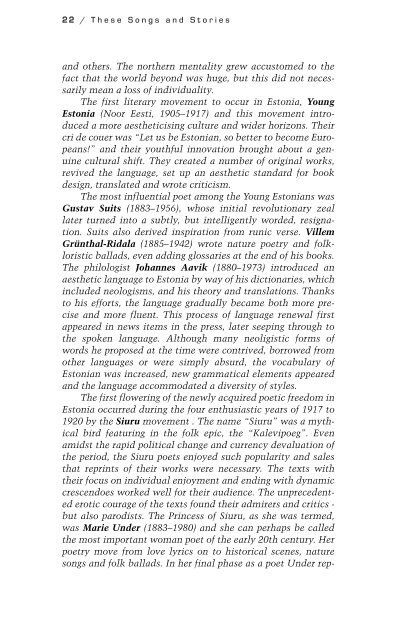*tuule makett - Infopoint Estonian Culture
*tuule makett - Infopoint Estonian Culture
*tuule makett - Infopoint Estonian Culture
Create successful ePaper yourself
Turn your PDF publications into a flip-book with our unique Google optimized e-Paper software.
2 2 / These Songs and Stories<br />
and others. The northern mentality grew accustomed to the<br />
fact that the world beyond was huge, but this did not necessarily<br />
mean a loss of individuality.<br />
The first literary movement to occur in Estonia, Young<br />
Estonia (Noor Eesti, 1905–1917) and this movement introduced<br />
a more aestheticising culture and wider horizons. Their<br />
cri de couer was “Let us be <strong>Estonian</strong>, so better to become Europeans!”<br />
and their youthful innovation brought about a genuine<br />
cultural shift. They created a number of original works,<br />
revived the language, set up an aesthetic standard for book<br />
design, translated and wrote criticism.<br />
The most influential poet among the Young <strong>Estonian</strong>s was<br />
Gustav Suits (1883–1956), whose initial revolutionary zeal<br />
later turned into a subtly, but intelligently worded, resignation.<br />
Suits also derived inspiration from runic verse. Villem<br />
Grünthal-Ridala (1885–1942) wrote nature poetry and folkloristic<br />
ballads, even adding glossaries at the end of his books.<br />
The philologist Johannes Aavik (1880–1973) introduced an<br />
aesthetic language to Estonia by way of his dictionaries, which<br />
included neologisms, and his theory and translations. Thanks<br />
to his efforts, the language gradually became both more precise<br />
and more fluent. This process of language renewal first<br />
appeared in news items in the press, later seeping through to<br />
the spoken language. Although many neoligistic forms of<br />
words he proposed at the time were contrived, borrowed from<br />
other languages or were simply absurd, the vocabulary of<br />
<strong>Estonian</strong> was increased, new grammatical elements appeared<br />
and the language accommodated a diversity of styles.<br />
The first flowering of the newly acquired poetic freedom in<br />
Estonia occurred during the four enthusiastic years of 1917 to<br />
1920 by the Siuru movement . The name “Siuru” was a mythical<br />
bird featuring in the folk epic, the “Kalevipoeg”. Even<br />
amidst the rapid political change and currency devaluation of<br />
the period, the Siuru poets enjoyed such popularity and sales<br />
that reprints of their works were necessary. The texts with<br />
their focus on individual enjoyment and ending with dynamic<br />
crescendoes worked well for their audience. The unprecedented<br />
erotic courage of the texts found their admirers and critics -<br />
but also parodists. The Princess of Siuru, as she was termed,<br />
was Marie Under (1883–1980) and she can perhaps be called<br />
the most important woman poet of the early 20th century. Her<br />
poetry move from love lyrics on to historical scenes, nature<br />
songs and folk ballads. In her final phase as a poet Under rep-


